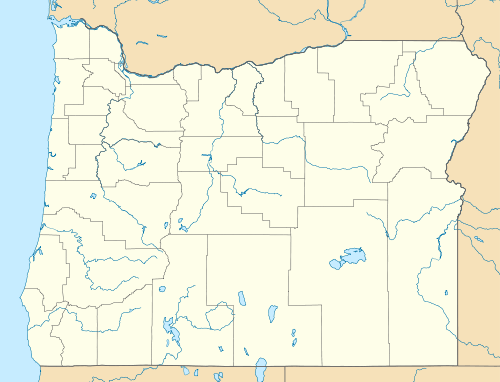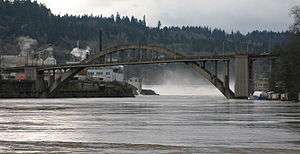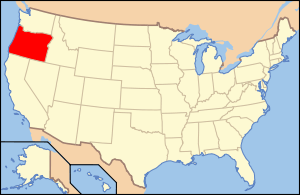Oregon City Bridge
| Oregon City Bridge | |
|---|---|
_-_1.jpg) | |
| Carries |
|
| Crosses | Willamette River |
| Locale |
Oregon City to West Linn, Oregon, USA |
| Maintained by | Oregon DOT |
| Characteristics | |
| Design |
through arch of hollow box girder construction |
| Total length | 745 ft (227 m) |
| Longest span | 360 ft (110 m) |
| History | |
| Opened |
December 28, 1922 |
|
Willamette River Bridge (No. 357) | |
   | |
| Location | Oregon City, Oregon; Willamette River at river mile 26.0 |
| Coordinates | 45°21′32.6″N 122°36′34.9″W / 45.359056°N 122.609694°WCoordinates: 45°21′32.6″N 122°36′34.9″W / 45.359056°N 122.609694°W |
| Built | 1922 |
| Architect | Conde B. McCullough |
| NRHP Reference # | 05000639[1] |
| Added to NRHP | July 1, 2005[1] |
The Oregon City Bridge is a steel through arch bridge spanning the Willamette River between Oregon City and West Linn, Oregon, United States. Completed in 1922, it is listed on the National Register of Historic Places. It was built and is owned by the Oregon Department of Transportation (ODOT) as part of Oregon Route 43 and is the third southernmost Willamette bridge in the Portland metropolitan area, after the Boone Bridge in Wilsonville and the Oregon 219 bridge near Newberg.
The bridge is 745 ft (227 m) in length and 28 ft (8½ m) wide with a 360 ft (110 m) long main span that provides 49 ft (15 m) of vertical clearance at low river levels. The narrow width causes problems for large vehicles that cross it, often requiring traffic going in the other direction to stop. TriMet buses ceased using the bridge in 2009.
This bridge is the only Oregon bridge to be encased in gunite, which protects it from corrosive sulfur dioxide emissions from paper mills south of the bridge. The concrete look was favored by bridge designer Conde McCullough, designer of 500 Oregon bridges. His signature detailing is evident in the obelisk pylons with sconced light fixtures, ornate railings, and Art Deco piers.[2]
The Oregon City Bridge is just downstream from the 40 ft (12 m) tall Willamette Falls and the Willamette Falls Locks, the oldest navigational locks in the United States. Downstream from this bridge is the George Abernethy Bridge, which carries Interstate 205.
History
The bridge was built to replace an 1888 pedestrian suspension bridge; workers used the old bridge to begin construction of the present bridge's box steel ribs.[3] Construction was made difficult by the great depth of the river at the bridge site and by the water traffic during construction. Construction workers used the cables of the old bridge to support the arch prior to completion by running cables from the arch, over the cables to an anchor on the far side. Once the new arch was completed, the old suspension bridge was dismantled.[4] The present bridge was opened for public use on December 28, 1922; the cost of construction was published as $300,000.[5]
The piers were designed to accommodate public restrooms. The deck widens at the piers to provide room for the stairways – one on each side of the deck – that once descended to the restrooms. Repeated vandalism led to the closure of the restrooms in 1937, and the stairway entrances were covered over with concrete. Windows for "observation balconies" that were originally included in the piers, at the tops on both sides, were also sealed in concrete after closure.[6]
The bridge was added to the National Register of Historic Places (as the Willamette River (Oregon City) Bridge (No. 357)) on July 1, 2005.[1][7]
In March 2009, ODOT imposed new weight limits for vehicles crossing the bridge, after inspections revealed damage to some of the structure's floor beams. Large commercial vehicles, or any vehicle weighing more than 14 tons, were banned from using the bridge.[8] Among other impacts, the restriction meant the rerouting of all TriMet buses. The two routes using the bridge at that time, 35-Macadam and 154-Willamette, were rerouted across the Abernethy Bridge (I-205 bridge).[8][9]
In 2010–2012, the Oregon City Bridge was given an extensive rehabilitation, overseen by ODOT. Work began in July 2010,[10] and the bridge was temporarily closed to all traffic starting in January 2011.[11][12] The bridge reopened on October 15, 2012,[13] with the $15 million restoration project nearly completed. The final items of work were completed in early 2013.[10] According to ODOT, one of the "intentions" of the project was to "restore [the bridge's] original load-carrying capacity",[14] which would permit TriMet buses to resume using the bridge. However, as of September 2013 TriMet service had not returned to the bridge, and it is unknown whether the transit agency is planning to restore the former routings, or whether ODOT actually has restored the old (higher) load limits.
Current use
As of 2000, the bridge carried 12,800 vehicles per day, which represents only a 40% growth in traffic since 1953, when a public debate was held about building a parallel bridge next to the existing bridge. While the Oregon City Bridge did not get twinned, the George Abernethy Bridge (I-205 Bridge) opened in 1970 and has since become the major route through the area. TriMet buses crossed the bridge until March 2009, when a new weight limit temporarily banned buses and heavy commercial vehicles from using the bridge.[9]
Gallery
 Oregon City bridge as seen from McLoughlin Promenade
Oregon City bridge as seen from McLoughlin Promenade Surface view looking toward Oregon City
Surface view looking toward Oregon City Former restroom stairway entrance, flanked by art-deco lighting fixtures
Former restroom stairway entrance, flanked by art-deco lighting fixtures View from northeast, with Willamette Falls in background
View from northeast, with Willamette Falls in background Interior of bridge with bottom of Oregon City Municipal Elevator visible
Interior of bridge with bottom of Oregon City Municipal Elevator visible Looking up at Oregon City Bridge from Frontier Street in West Linn, in 2007, before lights were reinstalled on the obelisks
Looking up at Oregon City Bridge from Frontier Street in West Linn, in 2007, before lights were reinstalled on the obelisks.jpg) Fireworks in celebration of the bridge's reopening in 2012 after a two-year rehabilitation
Fireworks in celebration of the bridge's reopening in 2012 after a two-year rehabilitation
See also
- List of bridges on the National Register of Historic Places in Oregon
- List of crossings of the Willamette River
References
- 1 2 3 "National Register of Historic Places: Weekly list of actions taken on properties: 7/25/05 through 7/29/05". National Park Service. August 5, 2005. Retrieved April 24, 2013.
- ↑ Smith, Dwight A.; Norman, James B.; Dykman, Pieter T. (1989). Historic Highway Bridges of Oregon. Oregon Historical Society Press. p. 96. ISBN 0-87595-205-4.
- ↑ Hadlow, Robert W. (2001). Elegant Arches, Soaring Spans: C.B. McCullough, Oregon's Master Bridge Builder. Oregon State University Press. pp. 51–53. ISBN 0-87071-534-8.
- ↑ "Old Bridge, Doomed, Helps to Build Successor". Popular Science Monthly. November 1922. p. 39.
- ↑ Wood, Sharon (2001). The Portland Bridge Book. Oregon Historical Society. ISBN 0-87595-211-9.
- ↑ James A. McNett (June 4, 2004). "National Register of Historic Places Registration Form: Willamette River (Oregon City) Bridge (No. 357)" (PDF). National Park Service. Retrieved September 30, 2013.
- ↑ "Oregon National Register List" (PDF). Oregon Parks and Recreation Department. June 6, 2011. p. 4. Retrieved April 24, 2013.
- 1 2 "Traffic Advisory: New Restrictions on Oregon City Arch Bridge" (PDF). Oregon Department of Transportation. March 2, 2009. Retrieved June 6, 2013.
- 1 2 Roberts, Anthony (March 3, 2009). "Damaged beams force weight limits on historic OC bridge". Portland Tribune. Retrieved June 6, 2013.
- 1 2 "OR 43: Oregon City–West Linn Arch Bridge Rehabilitation Project". Oregon Department of Transportation. January 2013. Retrieved June 6, 2013.
- ↑ Mayes, Steve (January 7, 2011). "Historic Oregon City-West Linn bridge closes Jan. 15 for 2-year upgrade". The Oregonian. Retrieved June 6, 2013.
- ↑ "OR 43: Oregon City–West Linn Arch Bridge Rehabilitation Project". Oregon Department of Transportation. July 2012. Archived from the original on August 21, 2012. Retrieved June 6, 2013.
- ↑ Hottman, Sara (October 14, 2012). "Long-awaited Arch Bridge re-opening marked with three-day festival, vow renewal". The Oregonian. Retrieved 15 October 2012.
- ↑ "Media Advisory: Ceremonial re-opening Sunday of the Arch Bridge" (PDF). ODOT. p. 2. Retrieved June 6, 2013.
- Historic American Buildings Survey/Historic American Engineering Record. Willamette River Bridges Recording Project (HAER OR-31). National Park Service and ODOT, 1992
External links
| Wikimedia Commons has media related to Oregon City Bridge. |
- Oregon City Bridge (with a link to an Microsoft Word document about the bridge), from the website of the state of Oregon
- Built in America list with link to bridge information, from the Library of Congress website
- Photo of 1888 suspension bridge, from a bridge fan's website
- Historic American Engineering Record (HAER) No. OR-31, "Willamette River Bridge, Spanning Willamette River on Oswego Highway 3, Oregon City, Clackamas County, OR", 20 photos, 2 color transparencies, 30 measured drawings, 10 data pages, 4 photo caption pages

